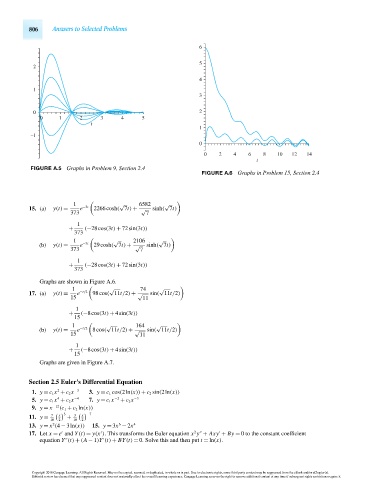Page 826 - Advanced_Engineering_Mathematics o'neil
P. 826
806 Answers to Selected Problems
6
5
2
4
1
3
0 2
0 1 2 3 4 5
t
1
–1
0
0 2 4 6 8 10 12 14
t
FIGURE A.5 Graphs in Problem 9, Section 2.4
FIGURE A.6 Graphs in Problem 15, Section 2.4
1 √ 6582 √
15. (a) y(t) = e −3t 2266cosh( 7t) + √ sinh( 7t)
373 7
1
+ (−28cos(3t) + 72sin(3t))
373
1 √ 2106 √
(b) y(t) = e −3t 29cosh( 7t) + √ sinh( 7t)
373 7
1
+ (−28cos(3t) + 72sin(3t))
373
Graphs are shown in Figure A.6.
1 √ 74 √
17. (a) y(t) = e −t/2 98cos( 11t/2) + √ sin( 11t/2)
15 11
1
+ (−8cos(3t) + 4sin(3t))
15
1 √ 164 √
(b) y(t) = e −t/2 8cos( 11t/2) + √ sin( 11t/2)
15 11
1
+ (−8cos(3t) + 4sin(3t))
15
Graphs are given in Figure A.7.
Section 2.5 Euler’s Differential Equation
2
1. y = c 1 x + c 2 x −3 3. y = c 1 cos(2ln(x)) + c 2 sin(2ln(x))
4
5. y = c 1 x + c 2 x −4 7. y = c 1 x −2 + c 2 x −3
9. y = x −12 (c 1 + c 2 ln(x))
3 −7
7 x 3 x
11. y = +
10 2 10 2
6
2
13. y = x (4 − 3ln(x)) 15. y = 3x − 2x 4
t
2
t
17. Let x = e and Y(t) = y(x ). This transforms the Euler equation x y + Axy + By = 0 to the constant coefficient
equation Y (t) + (A − 1)Y (t) + BY(t) = 0. Solve this and then put t = ln(x).
Copyright 2010 Cengage Learning. All Rights Reserved. May not be copied, scanned, or duplicated, in whole or in part. Due to electronic rights, some third party content may be suppressed from the eBook and/or eChapter(s).
Editorial review has deemed that any suppressed content does not materially affect the overall learning experience. Cengage Learning reserves the right to remove additional content at any time if subsequent rights restrictions require it.
October 14, 2010 17:50 THM/NEIL Page-806 27410_25_Ans_p801-866

